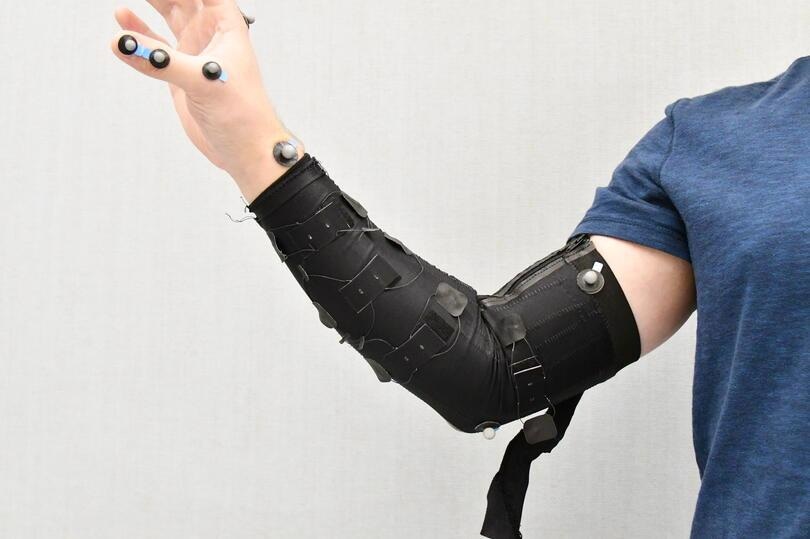
Image Credit: Oluwaseun Araromi, Harvard University
Parkinson’s disease affects close to one million people in the U.S. alone. It is caused by a deficiency in the transport of dopamines in neurons. This results in muscle tremors, limb rigidity and difficulties in walking. Wearable sensors integrated with MyoExo technology are set to provide researchers with valuable “muscle-centric physiological signature” data.
An Introduction to Exosuits
In the animal kingdom, an exoskeleton develops on the outside of an animal’s body and is formed of carbohydrates, proteins and minerals. While providing support for the internal organs, it is also lightweight and flexible, enabling the animal to move with ease.
Inspired by nature’s designs, exosuits are robotic training devices for correcting the gait of wearers that are manufactured from soft (flexible) materials, excluding any rigid structures which could restrict movement.
Thus exosuits, when equipped with wearable sensors, enable accurate adjustments to a wearer’s gait. Healthy individuals can learn to move more efficiently, while patients suffering from neurological or physical disorders can rehabilitate more quickly.
Exosuits attach to the wearer’s body comfortably (and securely) while redistributing forces along biomechanically efficient pathways. In fact, assistive forces can often be generated passively through natural movements alone without the need for active power.
Sensor systems based on off-the-shelf sensor technologies such as pressure sensors, gyro, and IMU can be integrated into soft fabrics and textiles to monitor key events in the gait cycle to record movements, track changes or enable control.
Moreover, active and passive redistribution of loads reduce the risks of injuries. This carries many benefits in applications beyond medicine, such as sports and military training.
Designing Wearable Sensors for Exosuits
The Harvard MyoExo project was based on technology already developed at Harvard University’s School of Engineering & Applied Sciences and the Wyss Institute for Biologically Inspired Engineering.
The project forms part of the Harvard Innovation Lab venture program. It builds on the work of Prof. Conor Walsh at the Harvard Biodesign Lab and Prof. Rob Wood at the Microrobotics Lab.
MyoExo has two aims — Namely, to build on advances in remote patient monitoring systems but also to build an early detection system for Parkinson’s disease.
MyoExo technology is based on a series of wearable sensors that can detect minute changes in muscle strain and bulging, thus providing rich physiological muscle data.
If we had these hypersensitive sensors in something that a person was wearing, we could detect how their muscles were bulging…that was more application-agnostic. We didn’t know exactly where that would be the most important, and I credit Seun and our Wyss collaborators for being the ones to think about identifying Parkinson’s applications.
Prof. Conor Walsh, Harvard Biodesign Lab
The technology is still in its early stages and needs to prove its accuracy in gathering clinically relevant data. The team wants to show how the technology can separate healthy muscle contractions from Parkinson’s induced muscle movements.
The next step is to separate the early and late stages of the disease. The proof of concept is being supported by the Wyss Institute Validation Project program.
In these early stages, Dr. Araromi sees the technology benefiting three stakeholders — Clinicians who could monitor the effectiveness of treatment regimes, the pharmaceutical industry, which could quantify medication dosages, and patients who could actively participate in their own recovery.
References and Further Reading
Chen, L., et. al., (2021) A Novel Lightweight Wearable Soft Exosuit for Reducing the Metabolic Rate and Muscle Fatigue. Biosensors, [online] Vol. 11 Issue 7 Available at: https://www.mdpi.com/2079-6374/11/7/215/htm
Sridar, S., et. al., (2018) A Soft-Inflatable Exosuit for Knee Rehabilitation: Assisting Swing Phase During Walking. Frontiers in Robotics and AI, [online] Available at: https://www.frontiersin.org/articles/10.3389/frobt.2018.00044/full
Goisman, M., (2022) Sensing Parkinson’s symptoms [online] Available at: https://www.seas.harvard.edu/news/2022/03/sensing-parkinsons-symptoms
Harvard Biodesign Lab. Soft Exosuits. [online] Available at: https://biodesign.seas.harvard.edu/soft-exosuits
Disclaimer: The views expressed here are those of the author expressed in their private capacity and do not necessarily represent the views of AZoM.com Limited T/A AZoNetwork the owner and operator of this website. This disclaimer forms part of the Terms and conditions of use of this website.